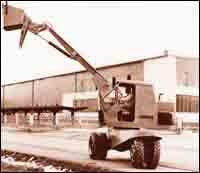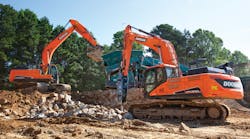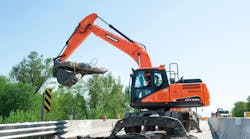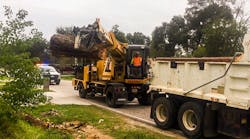In the 1950s, the heyday of cable-operated excavators, several manufacturers experimented with hydraulic systems in efforts to increase machine efficiency by replacing the cables with hydraulic cylinders and pistons. The road was long and arduous. The early machines suffered from leaky systems, blown hoses, and lack of power due to low-pressure hydraulic systems. These machines had poor reputations, but manufacturers persisted, developing new technologies and improving their product.
One pioneering company that helped boost the hydraulic excavator was Liebherr, originating in Kirchdorf, Germany. Founded by Hans Liebherr, who took over the family construction business in 1938, the firm entered the hydraulic excavator market in 1955 with its wheeled model L300 (shown).
The L300 had a capacity of 3/8 cubic yard and weighed approximately 10 tons. Initially in shovel form, the excavator added backhoe, clamshell and crane attachments. A year later, crawler and truck-mounted versions became available. In 1957, the revised ½-yard L350 appeared, and further upgrades resulted in the wheeled A353 and crawler R353 machines of the same capacity.
The Liebherr company greatly expanded in the 1960s and 1970s, establishing many subsidiary companies in foreign countries, including Newport News, Va., in 1970, and Colmar, France, in 1961. In 1960, Liebherr extended its range of excavators to include the 1-yard wheeled A750, the company's first with a hydraulically driven undercarriage. In 1960, the 1¼-yard crawler RT1000 appeared, Liebherr's largest at that time.
In 1968, Liebherr launched its 900-series excavators that laid the foundation for all subsequent models. Today, Liebherr's wide range of excavators covers sizes from 11 to 736 tons operating weight, and the company is one of only a handful supplying large excavators to the quarrying and surface-mining industries wielding buckets up to 47 cubic yards.
Today, hydraulic excavators work on every kind of construction job from road maintenance, trenching and foundation work to mass excavation on industrial sites, as well as in quarries and surface-mining operations.
Hydraulic excavators are less expensive to buy, easier to operate, and travel faster than the old cable excavators. They have positive action in all movements instead of relying on gravity to provide some of the digging forces. Backhoe and shovel fronts are the most common for hydraulic excavators, but manufacturers have developed a vast array of attachments so the machines not only dig, but also rip, hammer, lift, drill, saw, and compact as well. These attachments have greatly enhanced the excavator's usefulness and are a big factor in its rapidly increasing popularity.
You can read more about the evolution of construction equipment in Keith Haddock's illustrated book "The Earthmover Encyclopedia," available in most bookstores. Also, consider a membership in the Historical Construction Equipment Association, www.hcea.net.





